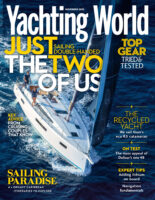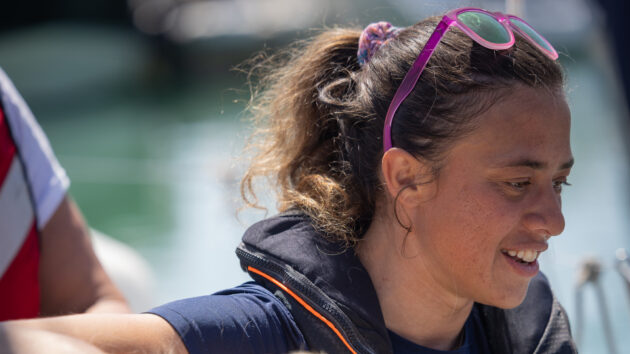Having been given just months to live, Jazz Turner sailed a solo circumnavigation around Britain. She explains why - and how - to Helen Fretter
On June 29 a lifeboat crew was attending a multicoloured little yacht that had run hard aground off Folkestone, on the south-east corner of England, in the early hours of the morning.
The yacht was a 27ft Albin Vega, sitting high and dry on the rocks, and its skipper a petite young sailor called Jazz Turner, who was in the closing stages of a solo circumnavigation of Britain – and also happens to use a wheelchair to get about on land.
At first glance, Turner and the Albin’s situation looked hopeless: the yacht would surely require towing off, the single-handed skipper would surely require assistance.
But the rescue crews were asked not to intervene. Jazz and her team had a plan, and she was going to get herself and her yacht out of this predicament on her own.
Despite her limited mobility Turner was able to kedge off and refloat after dragging first a bow and then a stern anchor out across the rocks.
It was a remarkable act of seamanship by any standards, but Turner spent hours crawling across the slippery shoreline, hauling anchors and chain that weighed nearly as much as her own 40kg frame, then pulling in on the stern anchor lines by hand to get the yacht’s rudders back into deeper water.
It worked, the Albin refloated – relatively unscathed – and Turner went on to complete one of the most incredible sailing achievements of recent years.
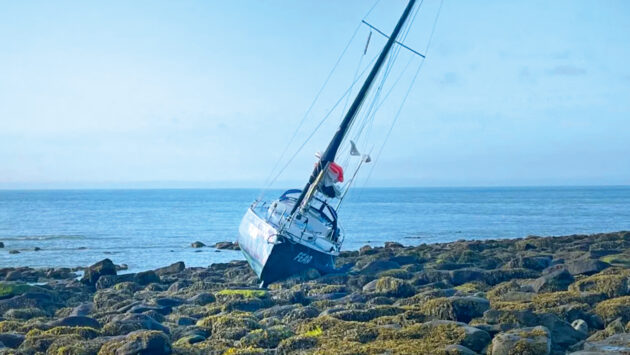
Turner’s yacht Fear aground just before her voyage end. Photo: Project Fear
Face everything and rise
Jazz Turner’s solo sailing circumnavigation was named Project Fear, and her beloved Albin is named Fear, for ‘face everything and rise’.
It’s an apt sentiment, as Turner has faced more adversity than most. She was initially drawn to sailing quite by chance – a school friend had been given a voucher for a day’s sailing experience as a birthday present, but the typical English summer weather was uninviting, cold and wet.
When her friend didn’t want to go, Turner jumped at the chance, and realised instantly that she loved it. She began dinghy sailing aged 13 at her local club, Newhaven & Seaford SC.
“I couldn’t afford my own boat, so I walked down to the club every Sunday morning, on Wednesday evenings after school. I’d go around the dinghy park and ask people if I could go sailing with them.
“Eventually they brought down a Topper for me from our club inland site, which I raced and learned to sail that way,” she recalls. From the Topper she progressed to the Laser (now ILCA) at Weir Wood SC, and helmed a double-handed Fireball dinghy.
Article continues below…
However, the sailing clubs weren’t just a source of fun. Turner had an unstable home life, often moving around, and finally left home as a teenager.
Fellow Fireball racer and friend Chris Turner realised Jazz’s situation and took her in – later formally adopting her. Sailing had not only given Jazz a passion and an outlet, but it also brought her a new family.
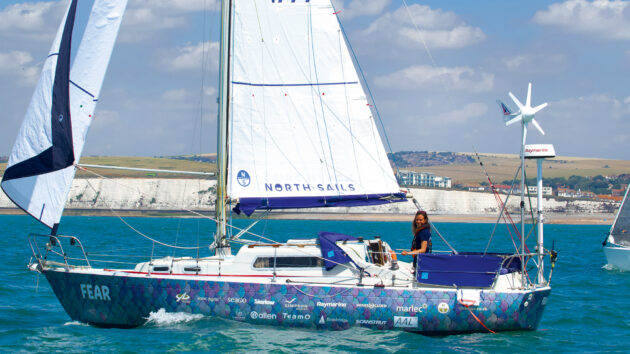
Jazz Turner approaches Brighton to complete her around Britain adventure. Photo: Ingrid Abery
Remarkable story
But that was far from the end of Turner’s remarkable story.
Due to her chaotic childhood, Turner had never had some unusual medical symptoms investigated. Chris Turner’s wife, Carolyn, is a GP and realised that some of the conditions Jazz lived with – frequently dislocating joints and unexplained allergies – needed proper diagnosis.
That diagnosis was Ehlers-Danlos Syndrome; a genetic, progressive condition, which affects connective tissue throughout the body, and over the years the condition has increased in severity.
On land Turner uses a wheelchair, as it’s painful to bear weight and she is liable to falling. Gastro-intestinal failure means her digestive system struggles to process food and drink.

Jazz has raced in a wide range of dinghy fleets including the RS200. Photo: c/o Jazz Turner
Her foster dad, Chris, explained to our sister title PBO: “She also has a Postural Orthostatic Tachycardia Syndrome (POTS) condition which means her heart rate goes through the roof; assistance dog Phoebe tells her to sit down before she passes out.
“When sailing she has a clever watch, which gives her a shorter warning of five minutes.”
In December Jazz was told her condition had become terminal, and she had months to live. She was just 26.
“They offered her a bed at the hospice but she’s a 26-year-old who wants to live life to the full. She might die quicker doing so but she’d rather do that than be in a hospice with tubes – that’s a jail sentence,” Chris explained.
Living every day
Living life to the fullest for Turner was always going to involve sailing.
Determined to continue despite her worsening physical symptoms, she had previously begun sailing Paralympic and adaptive classes, such as the 2.4mR and RS Venture. “I found out that I wouldn’t classify: even if sailing was re-included in the Paralympics I wouldn’t be able to go because my disability isn’t eligible.
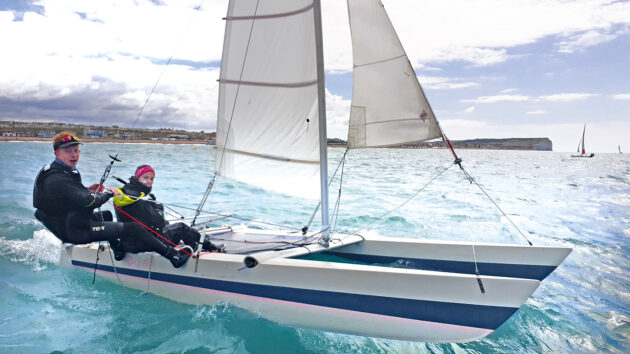
Racing in a Dart 15. Photo: c/o Jazz Turner
“I wanted to chase something similar to the Paralympics and still feel like I had a focus, so I switched over to big boats,” Jazz Turner recalls.
“But I was struggling to get opportunities crewing because people were scared of my wheelchair or scared of my disability. I was getting really frustrated. So I decided I’d get my own boat with the intention of potentially racing it or taking on some bigger challenge.
“I didn’t necessarily know what that challenge was: I just knew I needed my own boat.”
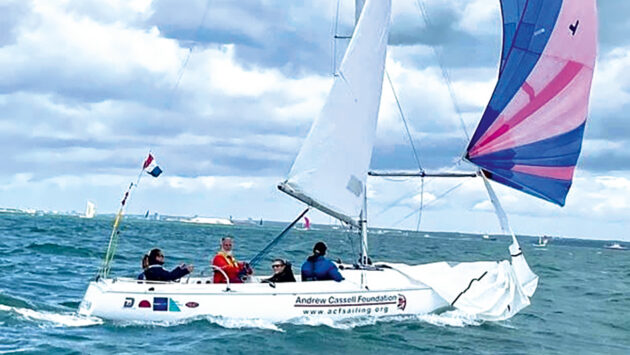
Sonar keelboat sailing in the Solent. Photo: c/o Jazz Turner
Chasing a dream
Turner had a total budget of £10,000 and bought the 1970s Albin for £6,000, leaving scant funds for the total overhaul required.
“She was pretty unmodified from when she was first built. She didn’t really have any modern electronics; it was all original winches, original rigging, original wiring.
“I had to totally rebuild her from the ground up,” Turner recalls.
Initially the shoestring refit was carried out by friends and family, but as Jazz’s plans crystalised into an around Britain challenge, more and more companies in the marine industry began to support her and she was able to make upgrades, including new sails and electronics.
Minor adaptations were made for her mobility: all lines are led to the centre cockpit, and fear sails downwind with a goosewinged jib rather than a spinnaker.
“Other than putting up the jib pole, there was no need to go on the foredeck at all,” she explains. “Then I have a series of straps that hold me onto the windward side of the boat, as well as a lot of handholds and extra supports so I could pull myself around using my body and not be reliant on my legs.”
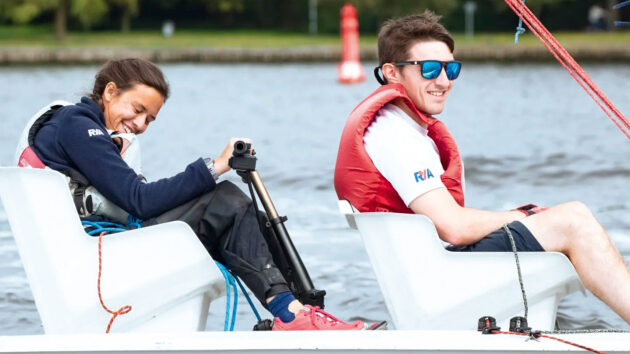
Turner also competed in Para sailing classes, including the SV 14. Photo: c/o Jazz Turner
It wasn’t until late 2024 that Jazz knew whether a truly solo sailing adventure would even be possible.
“It was nearing December when I finally did my first solo, solo sail. Up to that point I’d always had someone else on board as a backup.
“I went out, past Dover and back. It was a lot, but it was good. That was when I realised I was actually going to attempt this solo, non-stop and unassisted.”
Around Britain
Turner and Fear set off on their round Britain challenge on 2 June from Brighton marina.
It did not go well. “It was a brutal start, properly brutal. I had 20 knots of south-westerly, upwind, that didn’t drop for the first four days,” Jazz Turner recalls. “Everything, everything, that could have broken did break.
“It was exhausting physically, and very exhausting emotionally – because I thought we’d done loads of sailing to test everything, and then things were still breaking. I genuinely thought we’d be forced to turn around. I remember I was off Poole and my electronic compass had stopped working.
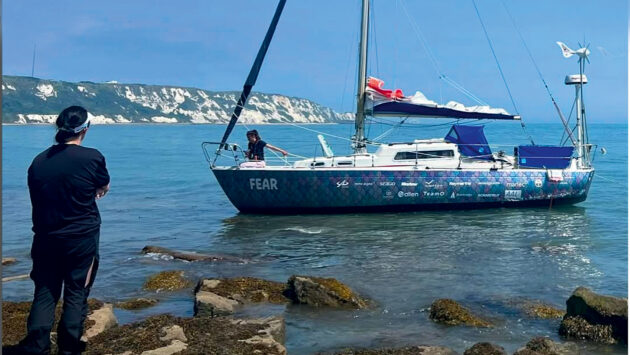
Showing true grit turner refloated the boat herself during her Round Britain. Photo: Project Fear
I was on the phone to my parents and dad said, ‘Look, it’s okay. You can come home. You can start again. We’ll start you again next week.’
“And everything in me wanted me to say yes, but all I could shout down on the phone was ‘no!’ – and then hang up on him, because how could he even say that? That was when I realised I was going to push on no matter what. It just might nearly kill me.”
When Jazz says the challenge might kill her, she’s not talking purely metaphorically. Maintaining body temperature and processing food are among the vital physical functions disrupted by Ehlers-Danlos Syndrome and even harder offshore.
Another complication is that her joints easily dislocate. “Without being able to brace my legs, I get thrown around an awful lot. Physically, that is massively exhausting and painful, but all my joints dislocate. So every time I get knocked, a joint falls out and I have to put it back in.
“If I do a tack wrong or something, I can knock my hip out, knock several fingers out. And then once the boat’s on the new tack, I’ve got to reattach and relocate all those joints and carry on sailing.
“It happens daily, so I’m used to it, but it doesn’t stop it from hurting. And I couldn’t take most of the pain relief because of the risks with drowsiness.”
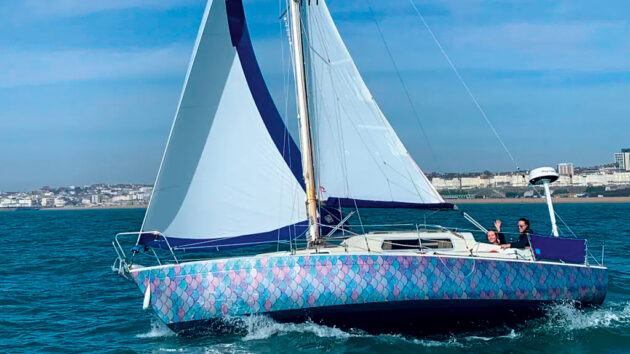
Sailing Round Britain
Over the top
Despite the rough start, Turner carried on. After nearly two weeks at sea, she realised she’d fallen into a rhythm.
“It was passing Fastnet rock on day 11. When I first started out in yachting, it was a Fastnet race year and I’d applied to loads of boats to do the race. I’d been turned down from each one – basically being told by teams that my disability was too complex and they couldn’t support me.
“So passing Fastnet was one of those moments where I suddenly thought we actually might pull this off!”
Fear was flying and the passage up the west coast of Scotland proved an unexpected treat. “It was really enjoyable. We had a breeze behind us pretty much the whole time, about 20 knots, just surfing down waves. So we made it to St Kilda by day 14, which was a lot faster than planned.”
Going into the challenge, Turner hadn’t set herself an end goal. “I didn’t set any expectations because I really didn’t know how long things would take – I never actually planned the second half of my route because I never thought I’d ever make it that far!” she recalls.

Turner’s yacht Fear aground. Photo: Project Fear
Second half
The return leg proved not so kind. “It was horrific. I thought by the point we were heading south, the worst had to be over. But the east coast and North Sea lived up to its reputation. A short, sharp, chop that was uncomfortable to sail through.
“Not nice for the boat, not nice for me, not good for the autopilot. That combined with the fact that you were having to slalom between oil rigs, tankers, and wind farms. It was pretty bloody miserable.”
Turner had onshore weather routing from Paralympian and offshore racer Hannah Stodel, and would check in twice a day via satellite communication.
“But a lot was just a case of keep going. There’s a massive storm coming? Reef, tough it out, carry on. Because once I’d turned south, there weren’t any anchorages I could get into and out of under sail alone.
“I think we saw 52 knots at one point in the North Sea. I was quite far offshore, and it was just a massive squall that came through. I was fully reefed and just drifted on the poles. But I had complete faith in Fear.
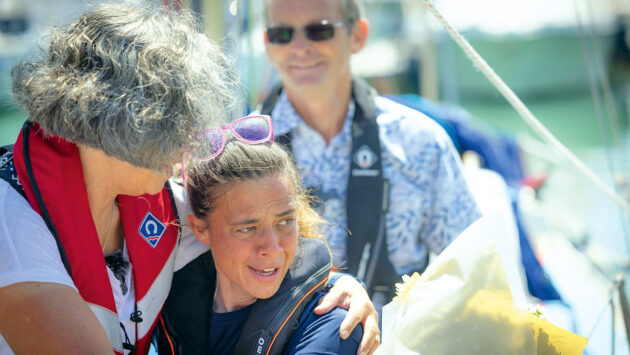
Turner is reunited with her parents, Chris and Carolyn, at the end of her circumnavigation. Photo: Fergus Kennedy
“She didn’t let me down in the slightest. She’s a bomb-proof little thing.”
The only point Jazz’s challenge was in true jeopardy was that grounding the night before she finished. “I was essentially drifting because there was no wind and an awful lot of tides. So I went inside to check the chartplotter, and I must have fallen asleep.
“The next thing I know, all the alarms were going off and I can see I’m in less than a metre of water. I throw myself out the companionway, look up to see the cliff, then chuck the rudder over to try and tack out to sea. But we’d hit and it was too late.”
After calling her family and team she formulated the strategy of using anchors to winch herself out.
Even getting on and off the beached yacht required some quick thinking. “The boat was high and dry, on its side. So I was able to slide off the front. I had on board a long piece of rope with a load of knots in, so I tied that onto the windward guardrail, and then I could pull myself back on board by pulling myself up the knots on the rope.”
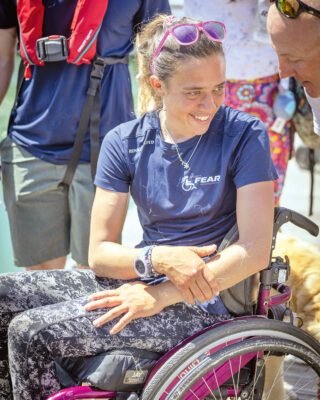
Ashore after her circumnavigation. Photo: Fergus Kennedy
Success recognised
Jazz Turner completed her round Britain by sailing back into Brighton marina on 30 June after 28 days and 2,070 miles of sailing. She became the first disabled person to sail around the British Isles solo and unsupported.
Huge crowds turned out to greet her, her adventure having drawn the support of sailing A-listers including Ben Ainslie, Dame Ellen MacArthur, Pip Hare, and Ian Walker.
The achievement took a while to sink in. “This project started as nothing more than something to keep me going at a time where I didn’t really see any hope or any future for myself,” she reflects.
“It was very much a personal challenge. The fact that it has inspired so many people to believe they can do more than what’s expected of them – that’s a great bonus.”
However, Turner is not done adventuring yet. “I think i’m going to attempt a transatlantic in fear next year. I learned a lot while I was out there,” she said. She is also seeking sponsorship to compete in the RWYC’s 2026 Worldstar Solo Round The World Race.
“Pretty much immediately afterwards, it’s been, ‘oh, what can I do next?’ I don’t think I’ll ever be done.”
 If you enjoyed this….
If you enjoyed this….
Yachting World is the world’s leading magazine for bluewater cruisers and offshore sailors. Every month we have inspirational adventures and practical features to help you realise your sailing dreams.Build your knowledge with a subscription delivered to your door. See our latest offers and save at least 30% off the cover price.
Note: We may earn a commission when you buy through links on our site, at no extra cost to you. This doesn’t affect our editorial independence.

